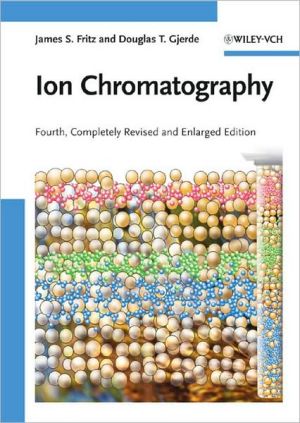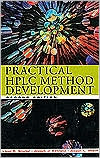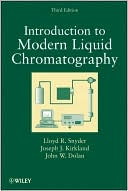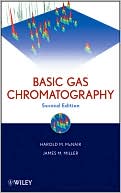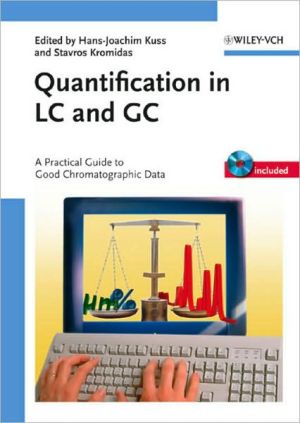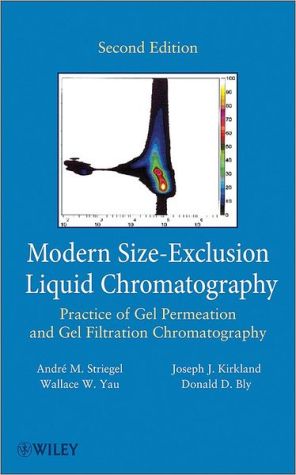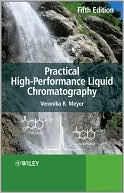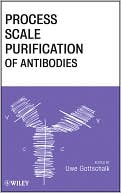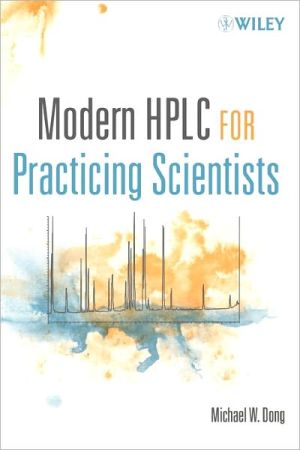Ion Chromatography
This separation method is increasingly finding applications in environmental, food, pharmaceutical and clinical analysis.
Search in google:
This separation method is increasingly finding applications in environmental, food, pharmaceutical and clinical analysis.The completely revised and updated fourth edition of this best-selling classic is a thorough treatment of the subject while remaining concise and readable. Alongside ion exchange resins, detectors, ion chromatographic separations, anion, cation and ion exclusive chromatography, special techniques and chemical speciation, new additions include capillary electrophoresis, monolithic columns, zwitterion columns, DNA/RNA analysis, fundamentals of the science of IC, and micro methods. The whole is rounded off by handy tables with details on, among others, detection or elution conditions, making this a ready reference for analytical, environmental and food chemists, chromatographers, pharmaceutists, and chemists working in trace analysis.
Preface 13Acknowledgments 151 Introduction and Overview 11.1 Introduction 11.2 Historical Development 21.2.1 Early Ion-Exchange Separations 21.2.2 Cation Separations 31.2.3 Separation of Anions 61.2.4 On-line Detection 81.2.5 The Birth of Modern Ion Chromatography 81.2.6 Non-Suppressed-Ion Chromatography 101.3 Principles of Ion Chromatographic Separation and Detection 131.3.1 Requirements for Separation 131.3.2 Experimental Setup 131.3.3 Performing a Separation 141.3.4 Migration of Sample Ions 151.3.5 Detection 171.3.6 Basis for Separation 172 Instrumentation 212.1 Components of an Ion Chromatography (IC) Instrument 212.2 General Considerations 232.3 Eluent 242.4 Pump 262.4.1 Gradient Formation 292.5 Sample Injector 302.6 Columns 312.6.1 Column Hardware 312.6.2 Column Protection 322.6.3 Column Oven 332.6.4 Two-dimensional IC 332.7 Suppressor 332.8 Detector 342.9 Data Acquisition and Calculation of Results 353 Resins and Columns 373.1 Introduction 373.2 Polymeric Resins 383.2.1 Substrate and Cross Linking 383.2.2 Microporous Resins 393.2.3 Macroporous Resins 403.2.4 Chemical Functionalization 413.2.5 Resin Capacity 423.3 Resins and Columns for Ion Chromatography 433.3.1 Monolith Columns 433.4 Anion Exchangers 453.4.1 Porous Anion Exchangers 453.4.2 Effect of Functional Group on Selectivity 473.4.3 Effect of Spacer Arm Length 523.4.4 Latex Agglomerated Ion Exchangers 543.4.4.1 Effect of Latex Functional Group on Selectivity 563.5 Cation Exchangers 573.5.1 Sulfonated Resins 573.5.2 Weak-acid Cation Exchangers 613.5.3 Other Types 633.6Other Resins 633.6.1 Chelating Ion-exchange Resins 633.6.2 Metal Oxides 643.6.3 Multi-purpose Resins 643.6.4 Ion-exchange Disks 654 Detectors 694.1 Introduction 694.2 Conductivity Detectors 704.2.1 Conductivity Definitions and Equations 734.2.2 Principles of Cell Operation 744.2.3 Conductance Measurement 754.2.4 Conductivity Hardware and Detector Operation 754.2.5 Contactless Conductivity Detection 764.3 Ultraviolet-Visible (UV-Vis) Detectors 774.3.1 UV-Vis measurement 774.3.2 Direct Spectrophotometric Measurement 784.3.3 Post-column Derivatization 814.3.4 UV-Vis Hardware and Detector Operation 824.4 Fluorescence Detector 834.5 Electrochemical Detectors 854.5.1 Potentiometric Detection 864.5.2 Conductometric Detectors 864.5.3 Amperometric/Coulometric Detection 874.5.4 Pulsed Electrochemical Detection (PED) 894.5.4.1 Pulsed Amperometric Detection (PAD) 914.5.4.2 Integrated Pulsed Amperometric Detection (IPAD) 934.5.4.3 IC-PED 944.5.5 Post-column Derivatization 954.5.6 Electrochemical Hardware and Detector Operation 954.6 Refractive Index Detector 974.7 Evaporative Light Scattering Detector (ELSD) 974.7.1 Nebulizer 984.7.2 Evaporation Chamber 994.7.3 Detection Cell 994.8 Other Detectors 1005 Principles of Ion Chromatographic Separations 1055.1 General Considerations 1055.2 Chromatographic Terms 1055.2.1 Retention Factor 1065.3 Selectivity 1095.3.1 Selectivity Coefficients 1105.3.2 Other Ion-exchange Interactions 1125.3.3 Selectivity of Sulfonated Cation-exchange Resin for Metal Cations 1135.3.4 Factors Affecting Selectivity 1205.3.4.1 Polymeric Matrix Effect 1215.3.4.2 Resin Functional Group 1225.3.4.3 Solvation Effects 1235.4 Chromatographic Efficiency 1246 Anion Chromatography 1316.1 Scope and Conditions for Separation 1316.1.1 Columns 1326.1.2 Separation Conditions 1356.2 Suppressed Anion Chromatography 1386.2.1 Electrolytic Suppressors 1406.2.2 Solid-Phase Reagents, 1990[7] 1416.2.3 Typical Separations 1426.2.3.1 Isocratic and Gradient Elution 1446.2.3.2 Influence of Organic Solvents 1466.3 Nonsuppressed Ion Chromatography 1476.3.1 Principles 1476.3.2 Explanation of Chromatographic Peaks 1506.3.3 Eluent 1506.3.3.1 General Considerations 1506.3.3.2 Salts of Carboxylic Acids 1516.3.3.3 Basic Eluents 1526.3.3.4 Carboxylic Acid Eluents 1536.3.4 System Peaks 1546.3.5 Scope of Anion Separations 1556.3.6 Sensitivity 1556.3.6.1 Conductance of a Sample Peak 1586.4 Coated Columns 1606.5 Optical Absorbance Detection 1636.5.1 Introduction 1636.5.2 Direct UV Absorption 1636.5.3 Indirect Absorbance 1646.6 Detection 1666.7 Pulsed Amperometric Detector (PAD) 1686.8 Evaporative Light Scattering Detector (ELSD) 1706.9 Inductively Coupled Plasma Methods (ICP) 1726.9.1 Atomic Emission Spectroscopy (AES) 1726.9.2 Inductively Coupled Plasma Mass Spectrometry (ICP-MS) 1737 Cation Chromatography 1757.1 Introduction 1757.2 Columns 1767.2.1 Historical Development 1787.2.2 Phosphonate Columns 1797.2.3 Macrocycle Columns 1817.2.4 Surfactant Columns 1827.3 Separations 1847.3.1 Suppressed-Conductivity Detection 1847.3.2 Non-Suppressed-Conductivity Detection 1877.3.3 Spectrophotometric Detection 1887.4 Effect of Organic Solvents 1917.4.1 Separation of Alkali Metal Ions 1937.5 Separation of Metal Ions with a Complexing Eluent 1957.5.1 Principles 1957.5.2 Separations 1967.5.3 Use of Sample Masking Reagents 1977.5.4 Weak-Acid Ion Exchangers 1987.6 Chelating Ion-Exchange Resins and Chelation Ion Chromatography 2017.6.1 Fundamentals 2017.6.2 Examples of Metal-Ion Separation 2048 Ion-Exclusion Chromatography 2078.1 Principles 2078.1.1 Equipment 2098.1.2 Eluents 2098.1.3 Detectors 2108.2 Separation of Organic Acids 2118.2.1 Effect of Alcohol Modifiers 2148.2.2 Separation of Carboxylic Acids on Unfunctionalized Columns 2168.3 Simultaneous Determination of Anions and Cations 2178.4 Conclusions 2208.5 Determination of Carbon Dioxide and Bicarbonate 2228.5.1 Enhancement Column Reactions 2228.6 Separation of Bases 2238.7 Determination of Water 2268.7.1 Determination of Very Low Concentrations of Water by HPLC 2298.8 Separation of Saccharides and Alcohols 2308.8.1 Introduction 2308.8.2 Separation Mechanism and Control of Selectivity 2308.8.3 Detection 2358.8.4 Contamination 2359 Ion Pair Chromatography 2399.1 Principles 2399.2 Typical Separations 2429.3 Mechanism 24610 Zwitterion Stationary Phases 25110.1 Introduction 25110.2 Simultaneous Separation of Anions and Cations 25310.3 Separation of Anions 25510.4 Separation of Cations 25610.5 Mechanism 25911 Capillary Electrophoresis 26311.1 Introduction 26311.1.1 Steps in Analysis 26411.1.1.1 Capillary Pretreatment 26411.1.1.2 Sample Introduction 26411.1.1.3 Sample Run 26511.1.1.4 Detection 26511.2 Principles 26511.2.1 Terms and Relationships 26511.2.2 Zone Broadening 26711.2.3 Sample Injection 26711.3 Electrosmotic Flow (EOF) 26811.3.1 Effect of EOF on Separations 27011.3.2 Control of EOF 27111.4 Separation of Ions 27411.4.1 Separation of Anions 27411.4.1.1 Separation of Isotopes 27611.4.2 Separation of Cations 27811.4.3 Separations at Low pH 27911.4.4 Capillary Electrophoresis at High Salt Concentration 28011.5 Capillary Electrophoretic Ion Chromatography 28311.5.1 Micellar Electrokinetic Chromatography (MEKC) 28411.5.2 Partial Complexation 28511.5.3 Effect of Ionic Polymers 28711.5.4 Effect of Alkylammonium Salts 29111.5.4.1 Separation Mechanism 29411.6 Summary 29412 DNA and RNA Chromatography 29912.1 Introduction 29912.1.1 Importance of DNA and RNA Chromatography 29912.1.2 Organization of this Chapter 30012.2 DNA and RNA Chemical Structure and Properties 30112.3 DNA and RNA Chromatography 30312.3.1 Development of DNA and RNA Chromatography 30312.3.2 Column Properties 30512.3.3 Ion-pairing Reagent and Eluent 30612.4 Temperature Modes of DNA and RNA Chromatography 30712.4.1 Nondenaturing Mode 30712.4.2 Fully Denaturing Mode 30812.4.3 Partially Denaturing Mode 30912.5 Instrumentation 31012.5.1 Effect of Metal Contamination 31012.5.2 The Column Oven 31312.5.3 UV and Fluorescence Detection 31312.5.4 Fragment Collection 31412.6 Applications of DNA Chromatography 31412.6.1 Dhplc 31412.6.2 Nucleic Acid Enzymology 31512.6.2.1 Telomerase Assays 31512.6.2.2 Polynucleotide Kinase Assays 31612.6.2.3 Uracil DNA Glycosylase Assays 31712.7 Applications of RNA Chromatography 31712.7.1 Separation of Messenger RNA from Ribosomal RNA 31812.7.2 Analysis of Transfer RNA 31913 Sample Pretreatment 32313.1 Dilute and Shoot or Pre-treat the Sample? 32313.2 Particulate and Column-contaminating Matter 32413.3 Preconcentration 32513.3.1 Collection of Ions from Air 32513.3.2 Preconcentration of Ions in Water 32613.4 Sample Pretreatment 32813.4.1 Anions in Acids 32813.4.2 Neutralization of Strongly Acidic or Basic Samples 32813.4.3 Dialysis Sample Preparation 32913.4.3.1 Passive Dialysis 33013.4.3.2 Donnan (Active) Dialysis 33013.4.4 Isolation of Organic Ions 33314 Method Development and Validation 33514.1 Choosing a Method 33514.1.1 Define the Problem Carefully 33514.1.2 Experimental Considerations 33614.1.3 Example of Method Development 33814.2 Some Applications of Ion Chromatography 34014.3 Statistical Evaluation of Data 34114.3.1 Common Statistical Terms 34114.3.2 Distribution of Means 34414.3.3 Confidence Intervals 34514.4 Validation of Analytical Procedures 34714.4.1 Analytical Control 34915 Chemical Speciation 35315.1 Introduction 35315.2 Detection 35515.3 Chromatography 35615.4 Valveless Injection IC 35715.5 Speciation of some Elements 35915.5.1 Chromium 35915.5.2 Iron 36015.5.3 Arsenic 36115.5.4 Tellurium 36215.5.5 Selenium 36315.5.6 Vanadium 36415.5.7 Tin 36415.5.8 Mercury 36515.5.9 Other Metals 365Index 369
\ From the Publisher"Overall, this is a good book for those interested in the separation of small inorganic and organic ions. It takes the reader from beginner to intermediate level in terms of the understanding and practice of ion chromatography. It is an easy to read book and for those wishing to build up their knowledge of the topic quickly, it is strongly recommended." (Chromatographia, August 2010)\ "This new edition is a substantial expansion and update of the previous edition, and is strongly recommended for scientists seeking a broad overview of IC. I am sure that this fourth edition will continue the success of its predecessors." (Analytical and Bioanalytical Chemistry, Jan - June 2010)\ \ \
